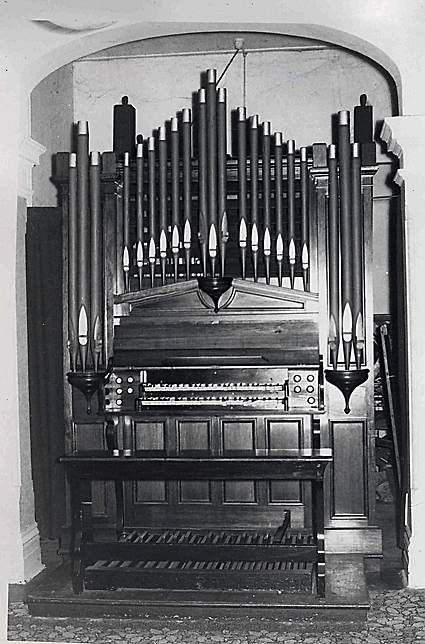

Historical and Technical Documentation by John Maidment
© OHTA, 2013 (last updated February 2013)
This small organ was placed in here until early 1965. The builder is unknown but the use of tubular-pneumatic action for the Pedal Bourdon would date it at later in the 19th century. It was certainly built locally but it is stylistically unlike most other locally built organs. It could be another example of the work of William Stone. Perhaps it was built by a gifted amateur. The house dated from the earlier years of the 20th century and appears still to survive – W.G.P. Wood was living there in 1910.1
The organ was placed in an alcove off the dining room. While it incorporated hand blowing, a hydraulic engine was also provided. The French-polished casework was very nicely finished. The Great Organ, which entirely consisted of wooden pipework, including a rare wooden Dulciana 8ft, was placed behind the Swell Organ, whose shutters were immediately behind the façade pipes, painted in green, with gold mouths. The manual pipework was planted on a common slider chest, with separate pallets for each division.
William George Percy Wood was an optician based at 95 Elizabeth Street, Melbourne and a Fellow of the Institute of Opthalmic Opticians. He died on 21 November 1949 and was survived by his wife and three sons.2
The organ was removed early in 1965 by W.S. Glasson and the parts dispersed.
| GREAT Stop Diapason Bass Stop Diapason & Clarabella Dulciana Flute Swell to Great SWELL Gedact Principal PEDAL Bourdon Great to Pedal |
8 8 8 4 8 4 16 |
CC-BB TC TC wood spotted metal, cone tuned, bass in façade |
Compass: 56/29
Mechanical key and stop action; tubular-pneumatic to pedal Bourdon
Lever swell pedal3
1 The Argus 26 October 1910, p.6
1 Ibid., 24 October 1929, p.6; 17 October 1934, p. 6; 23 November 1949, p.13
2 Details noted by John Maidment 1965